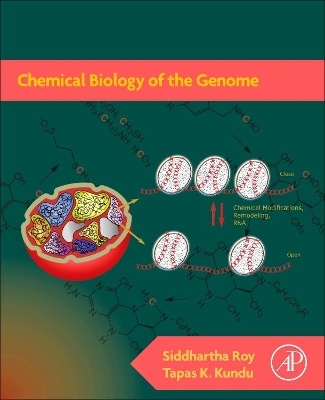
Chemical Biology of the Genome
Academic Press Inc (Verlag)
978-0-12-817644-3 (ISBN)
Later sections discuss chemical modifications of the genome, DNA sequence recognition by proteins and gene regulation, GWAS and EpiGWAS studies, 3D architecture of the genome, and functional genome architecture. In-depth, discovery focused chapters examine intervention in gene networks using SiRNA/ShRNA, miRNA, and anti-miR, small molecule modulation of iPS, drug resistance pathways altered DNA methylation as drug targets, anti-miR as therapeutics, and nanodelivery of drugs.
Prof. Siddhartha Roy is a renowned scientist in the field of Chemical Biology. He has made significant contributions in the area of transcription regulation. He was the Director of CSIR-Indian Institute of Chemical Biology (IICB), the first institution dedicated to Chemical Biology, for a decade. He is the Founder-President of Chemical Biology Society, India. Prof. Tapas K. Kundu has made outstanding contributions in the area of Epigenetic regulation of gene expression in humans in the context of disease and therapeutics. He has discovered several small molecule modulators of Epigenetic enzymes.
I. An integrative approach to chemical biology a) Philosophy behind the integrative approachb) Ensembles of molecules possess fundamentally different properties than individual moleculesc) Physical tools for studying ensembles and their propertiesd) Chemical Genetics: A powerful approach to study cellular functionse) Genes and Genomes: An integral entity
II. Genes, Genomes and Genome Dynamicsa) Genes: The building block Definition, identification, functional genes: an evolution in thoughts and ideasb) Genome: Complexity and Diversity. The organization of genes, the organization of genomes, the structure of chromatinc) Unstable genes: Biology and Chemistry. Unstable loci, why some genes are unstable (chemical and physical perspectives). Biological trigger for jumping genesd) The Dynamic Epigenome: Epigenetic Modifications and reversible changes. Reversible histone modifications, DNA methylation, Hydroxymethylation, Noncoding RNA and genome stability
III. Chemical modifications of the genomea) Electrophilic and Nucleophilic substitution reactionsb) DNA structurec) Chemical modifications of DNAd) Chemical modifications of proteinse) Enzymes involved in chemical modifications of proteins and DNAf) Modification of histones and their role in gene regulation
IV. DNA sequence recognition by proteins and gene regulationa) DNA recognition motifs of DNA-binding proteinsb) Sequence recognition versus shape recognitionc) Thermodynamics of sequence-specific recognitiond) Origin of sequence specificity, in prokaryotes and eukaryotese) Regulation of gene expression in prokaryotes: Chemical Principlesf) Regulation of gene expression in eukaryotes: Chemical Principlesg) Designed Transcription factors h) Gene regulatory networks
V. Elucidation of genome sequence and functional architecture by chemical biology approacha) Genome Sequencing: rapid evolution in the technologyb) Genome-wide Cooperation: GWAS and EpiGWAS:c) GWAS: Regulatory elements, Transcription and replication perspective, enhancer, super-enhancer, RNA pol II binding sitesd) EpiGWAS: methylome, histone modifications, book markinge) 3D architecture of the Genome: chromatin territories, CT and ICT relations (dynamics), small molecule metabolites interactions, functional foci, movements of territoriesf) Capturing the genome dynamics: capturing dynamic genome (3C to 5C) implications in disease diagnosis and prediction
VI. Chemical genomics: Understanding differentiation and disease (Using siRNA and small molecule)a) Intervention in gene networks using SiRNA/ShRNA, miRNA and anti-miRb) Small molecule modulation of iPSc) Elucidation of Neural and Muscle differentiation pathways by means of chemical biology approachd) Elucidation of Disease Biology e) Drug resistance pathways
VII. Chemical Biology: Drug discovery targeting the functional genomea) Using networks perspectives to discover drug targetsb) Altered DNA methylation as drug targets: DNMT inhibitor, DNMT inhibitor and metastasis, correlations with histone modificationsc) Combinatorial therapeutic molecules targeting in the reverse directiond) Targeting specific gene expression to counter Drug resistance: e) Anti-miR as therapeuticsf) Nanodelivery of drugs: a targeted Phenomenon. Classes of drug delivery vehicleg) Applications: receptor ligand modification and nano-vehicle, organ specific delivery, indirect targeting, tissue toxicity
| Erscheinungsdatum | 08.06.2021 |
|---|---|
| Verlagsort | San Diego |
| Sprache | englisch |
| Maße | 191 x 235 mm |
| Gewicht | 720 g |
| Themenwelt | Informatik ► Weitere Themen ► Bioinformatik |
| Naturwissenschaften ► Biologie ► Biochemie | |
| Naturwissenschaften ► Biologie ► Genetik / Molekularbiologie | |
| Naturwissenschaften ► Physik / Astronomie ► Angewandte Physik | |
| ISBN-10 | 0-12-817644-X / 012817644X |
| ISBN-13 | 978-0-12-817644-3 / 9780128176443 |
| Zustand | Neuware |
| Informationen gemäß Produktsicherheitsverordnung (GPSR) | |
| Haben Sie eine Frage zum Produkt? |
aus dem Bereich


